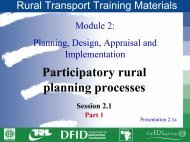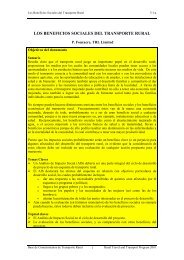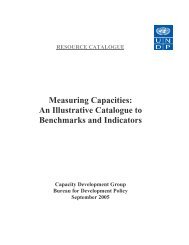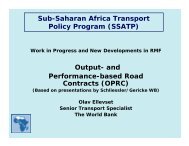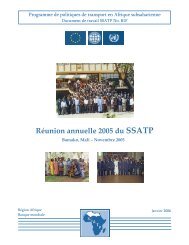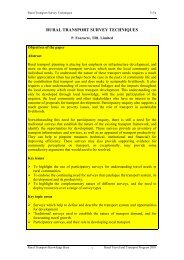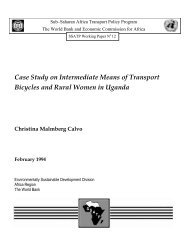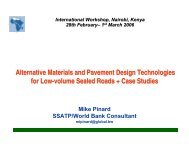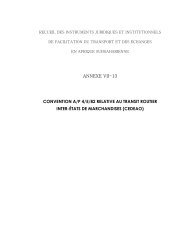Rural Access and Mobility in Pakistan - World Bank
Rural Access and Mobility in Pakistan - World Bank
Rural Access and Mobility in Pakistan - World Bank
You also want an ePaper? Increase the reach of your titles
YUMPU automatically turns print PDFs into web optimized ePapers that Google loves.
TRANSPORT NOTES<br />
ROADS, HIGHWAYS & RURAL TRANSPORT THEMATIC GROUP<br />
THE WORLD BANK, WASHINGTON, DC Transport Note No. TRN-28 December 2005<br />
<strong>Rural</strong> <strong>Access</strong> <strong>and</strong> <strong>Mobility</strong> <strong>in</strong> <strong>Pakistan</strong>:<br />
A Policy Note<br />
Mohammed Dalil Essakali<br />
This note presents a number of policy options to improve basic access <strong>and</strong> promote the mobility of <strong>Pakistan</strong>’s rural<br />
population <strong>in</strong> support of the Government’s Poverty Reduction Strategy. This is achieved through more focused <strong>and</strong><br />
community driven <strong>in</strong>terventions to meet the direct needs of the rural population. The current state of rural accessibility<br />
<strong>and</strong> mobility are exam<strong>in</strong>ed together with their effect on both the social <strong>and</strong> economic dimensions of rural poverty. Key<br />
challenges <strong>and</strong> constra<strong>in</strong>ts to reform are identified. The note contributes to the current debate with<strong>in</strong> <strong>Pakistan</strong> with regard<br />
to the better target<strong>in</strong>g of <strong>in</strong>terventions to assist the rural poor. It should also be of <strong>in</strong>terest to policy makers <strong>in</strong> other<br />
countries concerned with how rural transport policy may be developed to meet the Millennium Development Goals.<br />
The Note benefited from comments <strong>and</strong> suggestions by Navaid Qureshi, Simon Thomas, Amer Durrani, John H<strong>in</strong>e, Paul<br />
Amos, <strong>and</strong> Hernan Levy. It draws heavily on a study carried out by the <strong>World</strong> <strong>Bank</strong> <strong>Pakistan</strong> Transport Team <strong>in</strong> 2002<br />
(coord<strong>in</strong>ated by Ayaz Parvez), <strong>and</strong> its subsequent report on <strong>Rural</strong> <strong>Access</strong> <strong>and</strong> <strong>Mobility</strong> <strong>in</strong> <strong>Pakistan</strong> (<strong>World</strong> <strong>Bank</strong> 2003a <strong>and</strong><br />
2003b).<br />
SUMMARY<br />
The Challenge<br />
<strong>Rural</strong> areas <strong>in</strong> <strong>Pakistan</strong> are home to 100 million people<br />
or two thirds of the total population; they are also home<br />
to more than three quarters of the poor or 42 million<br />
people liv<strong>in</strong>g below the poverty l<strong>in</strong>e. One <strong>in</strong> every five<br />
villages, where 15 percent of the population live, is still<br />
not accessible 1 by all-weather motorable roads.<br />
Comb<strong>in</strong>ed by a lack of transport services <strong>in</strong> three of<br />
every ten villages, a large proportion of rural <strong>Pakistan</strong><br />
lacks motorized access to markets, basic services, as<br />
well as physical, social <strong>and</strong> political opportunities. Poor<br />
people <strong>and</strong> poor communities <strong>in</strong> rural <strong>Pakistan</strong> are least<br />
likely to have access to transport <strong>in</strong>frastructure <strong>and</strong><br />
services. At the same time, low accessibility to roads<br />
<strong>and</strong> transport services are associated with lower human<br />
development outcomes. For <strong>in</strong>stance, the data suggest<br />
that girls’ net primary school enrollment rate is 50<br />
percent higher <strong>in</strong> communities with all-weather<br />
motorable access. These communities also have higher<br />
<strong>in</strong>cidence of pre-natal medical consultation for women, a<br />
higher proportion of childbirths attended by skilled<br />
personnel, higher <strong>in</strong>cidence of post-natal consultation,<br />
<strong>and</strong> a lower probability of births at home. Without<br />
adequate transport accessibility, it is difficult to reduce<br />
vulnerability to natural <strong>and</strong> man-made disasters, a fact<br />
that has become pa<strong>in</strong>fully obvious <strong>in</strong> the aftermath of<br />
the October 2005 Earthquake. With<strong>in</strong> villages, rural<br />
households <strong>and</strong>, to a large extent, rural women bear a<br />
very high transport <strong>and</strong> travel burden associated with<br />
basic <strong>and</strong> social needs as well as economic activities.<br />
1 See def<strong>in</strong>ition of accessibility <strong>and</strong> its measurement <strong>in</strong><br />
Box 1.<br />
<strong>Rural</strong> roads expansion over the last two decades,<br />
averag<strong>in</strong>g over 2,000 kilometers per year, shows that<br />
<strong>Pakistan</strong> has made significant progress <strong>in</strong> connect<strong>in</strong>g<br />
rural communities to the rest of the country. However,<br />
like many other countries, <strong>Pakistan</strong> is struggl<strong>in</strong>g to meet<br />
with limited resources the grow<strong>in</strong>g dem<strong>and</strong> for transport<br />
<strong>in</strong>frastructure, <strong>and</strong> <strong>in</strong> many <strong>in</strong>stances it makes <strong>in</strong>efficient<br />
use of the very limited resources both <strong>in</strong> terms of<br />
allocative <strong>and</strong> technical efficiency. Resource allocation<br />
favors <strong>in</strong>vestment over ma<strong>in</strong>tenance, <strong>and</strong> the growth of<br />
the network has been concentrated on the prov<strong>in</strong>cial<br />
highway <strong>and</strong> district council road categories, with a clear<br />
bias towards the pav<strong>in</strong>g of roads. S<strong>in</strong>ce the rural<br />
transport system lies at the lowest level of <strong>Pakistan</strong>’s<br />
transport system hierarchy, it usually receives less<br />
attention than the rest of the network, <strong>and</strong> when<br />
<strong>in</strong>terventions are decided to improve it, it is treated <strong>in</strong><br />
l<strong>in</strong>e with the same st<strong>and</strong>ards, procedures <strong>and</strong> practices<br />
used for the rest of the transport system. Hence, many<br />
government programs have been planned to address the<br />
immediate rural accessibility problem without a carefully<br />
designed policy <strong>and</strong> <strong>in</strong>stitutional framework to ensure<br />
the susta<strong>in</strong>ability of the programs. These programs very<br />
often tend to focus on physical connectivity <strong>in</strong>stead of<br />
services, <strong>and</strong> their implementation is subject to heavy<br />
political <strong>in</strong>fluence. The 2001 Government devolution<br />
policy has h<strong>and</strong>ed over ownership <strong>and</strong> management of<br />
rural roads to local governments, but implementation of<br />
this policy is still experienc<strong>in</strong>g a large set of problems<br />
from technical <strong>and</strong> f<strong>in</strong>ancial constra<strong>in</strong>ts, especially at the<br />
district level.<br />
In addition to transport <strong>in</strong>frastructure <strong>and</strong> services, rural<br />
areas <strong>in</strong> <strong>Pakistan</strong> are also lagg<strong>in</strong>g beh<strong>in</strong>d the rest of the<br />
country when it comes to other <strong>in</strong>frastructure services<br />
such as potable water, sanitation, <strong>and</strong> electricity. The<br />
Government’s poverty reduction strategy (GOP, 2003)<br />
emphasizes thus the need to achieve economic growth<br />
particularly <strong>in</strong> the rural areas, <strong>and</strong> to br<strong>in</strong>g the poor <strong>and</strong>
Page 2 Transport Note No. TRN-28 December 2005<br />
vulnerable <strong>and</strong> backward regions <strong>in</strong>to the ma<strong>in</strong>stream of<br />
development. It calls for the simultaneous provision of<br />
social <strong>and</strong> economic services <strong>and</strong> <strong>in</strong>frastructure, creat<strong>in</strong>g<br />
job opportunities, <strong>and</strong> improv<strong>in</strong>g governance as<br />
essential elements of the strategy. Improv<strong>in</strong>g the<br />
performance of the transport sector is one of the top<br />
priorities on the poverty reduction agenda. Align<strong>in</strong>g<br />
public <strong>in</strong>terventions <strong>and</strong> <strong>in</strong>vestments <strong>in</strong> the sector with<br />
the strategy’s goals needs to be enhanced.<br />
Key Recommendations<br />
This policy note outl<strong>in</strong>es a few key options <strong>and</strong> offers<br />
recommendations for further discussion <strong>and</strong> Government<br />
consideration.<br />
<br />
<br />
<br />
<br />
<br />
Policy <strong>and</strong> strategy formulation. Develop a<br />
national rural transport policy <strong>and</strong> strategy. The<br />
policy should be consistent with the<br />
Government’s overall plans for rural<br />
development. The policy should recognize that<br />
any susta<strong>in</strong>able approach has to be owned by<br />
the beneficiaries. Strategies support<strong>in</strong>g this<br />
policy <strong>and</strong> programs translat<strong>in</strong>g it <strong>in</strong>to practice<br />
have to be simple, gender sensitive, <strong>and</strong><br />
consistent with the technical, managerial <strong>and</strong><br />
f<strong>in</strong>ancial resource base of owners, providers,<br />
<strong>and</strong> regulators.<br />
Institutions, ownership, responsibility <strong>and</strong><br />
f<strong>in</strong>anc<strong>in</strong>g. Improve the current <strong>in</strong>stitutional<br />
arrangements for ownership, management <strong>and</strong><br />
f<strong>in</strong>anc<strong>in</strong>g of rural transport system <strong>in</strong><br />
accordance with the new devolution reality.<br />
Local governments should manage the core<br />
rural roads <strong>and</strong> be provided the capacity <strong>and</strong><br />
skills for do<strong>in</strong>g this efficiently. Communities <strong>and</strong><br />
farmer associations would choose which roads<br />
<strong>and</strong> paths they will own; the private sector will<br />
sell management services to the local road<br />
agencies <strong>and</strong> carry out physical works as well<br />
as provide transport services.<br />
Fund<strong>in</strong>g. Mobilize additional resources <strong>and</strong><br />
allocate fund<strong>in</strong>g more cost-effectively by<br />
target<strong>in</strong>g <strong>in</strong>vestments <strong>in</strong> ways that more<br />
directly benefit the poor; shift available<br />
resources from construction <strong>and</strong> pav<strong>in</strong>g of<br />
exist<strong>in</strong>g roads to expansion of basic motorable<br />
access <strong>and</strong> ma<strong>in</strong>tenance of exist<strong>in</strong>g networks,<br />
through partial spot improvement <strong>and</strong><br />
rehabilitation. Ma<strong>in</strong>tenance also helps provide<br />
jobs for local population.<br />
Cross- sectoral l<strong>in</strong>kages. Whenever possible<br />
design <strong>and</strong> implement development programs<br />
<strong>in</strong> rural areas that cost-effectively reduce the<br />
need to travel. These would <strong>in</strong>clude village<br />
water <strong>and</strong> energy supply, schools <strong>and</strong> health<br />
cl<strong>in</strong>ics, etc.<br />
Infrastructure. Promote community <strong>in</strong>volvement<br />
<strong>in</strong> plann<strong>in</strong>g <strong>and</strong> manag<strong>in</strong>g transport <strong>in</strong>frastructure<br />
improvements that respond to their<br />
needs. These improvements <strong>in</strong>clude upgrad<strong>in</strong>g<br />
of key paths <strong>and</strong> tracks used for the collection<br />
of water, firewood <strong>and</strong> fodder; <strong>and</strong> improve-<strong>in</strong>g<br />
the village street <strong>and</strong> dra<strong>in</strong>age systems.<br />
Intermediate means of transport. 2 Promote<br />
the use of IMT to reduce the workload<br />
associated with basic household needs,<br />
especially for women, <strong>and</strong> improve key paths<br />
<strong>and</strong> tracks.<br />
<br />
Motorized conventional transport services.<br />
Take active measures to remove constra<strong>in</strong>ts<br />
<strong>and</strong> promote service coverage <strong>in</strong> presently<br />
unserved rural areas. This should be done on a<br />
case-by-case basis especially <strong>in</strong> areas with low<br />
population density <strong>and</strong> high cost of provid<strong>in</strong>g<br />
the service, where public <strong>in</strong>terventions might<br />
be suitable <strong>in</strong>clud<strong>in</strong>g targeted subsidies when<br />
necessary <strong>and</strong> affordable.<br />
THE CURRENT STATE OF RURAL TRANSPORT<br />
The exact state of rural transport <strong>in</strong>frastructure <strong>and</strong><br />
services <strong>in</strong> <strong>Pakistan</strong> is not known with any precision.<br />
There have been some specific studies carried out by the<br />
Government or donor agencies, but they usually were<br />
either driven by specific projects or focused on a few<br />
regions. Overall, the total road network <strong>in</strong> <strong>Pakistan</strong> for<br />
example is estimated by the Federal Bureau of Statistics<br />
at about 252,000 km, <strong>in</strong>clud<strong>in</strong>g National Highways,<br />
Prov<strong>in</strong>cial Highways <strong>and</strong> Roads, district roads <strong>and</strong><br />
municipal <strong>and</strong> cantonment roads (Table 1). A study<br />
(JBIC, 2004) estimated that there are also about 50,000<br />
km of irrigation department <strong>in</strong>spection paths, but it is<br />
not known how much of this network is open to public<br />
use. District Council <strong>and</strong> irrigation department networks<br />
comprise the ma<strong>in</strong> local road system. In addition, there<br />
is an undesignated network of roads, tracks, trails <strong>and</strong><br />
paths, which have no recognized ownership <strong>and</strong> have<br />
developed largely through use. Ma<strong>in</strong>tenance is usually<br />
on ad hoc basis by communities. The 2001 Government<br />
devolution policy has h<strong>and</strong>ed over ownership <strong>and</strong><br />
management of <strong>in</strong>tra-district roads to local<br />
governments, but the question of ownership is still not<br />
clear as the implementation of the devolution policy is<br />
still at its early stage. Road-based freight <strong>and</strong> passenger<br />
transport <strong>in</strong> <strong>Pakistan</strong> are deregulated, <strong>and</strong> except from<br />
sett<strong>in</strong>g rates for <strong>in</strong>ter-city <strong>and</strong> urban passenger services,<br />
Government has no <strong>in</strong>volvement <strong>in</strong> the provision of<br />
services.<br />
While <strong>in</strong> 1990, <strong>Pakistan</strong>’s overall network was evenly<br />
split between paved <strong>and</strong> unpaved roads, paved roads<br />
have grown at a much greater pace than unpaved ones,<br />
<strong>and</strong> they represent currently some 60 percent of the<br />
total network. Less <strong>and</strong> less unpaved roads are be<strong>in</strong>g<br />
constructed, <strong>and</strong> the network’s condition is deteriorat<strong>in</strong>g<br />
cont<strong>in</strong>uously due to a severe lack of ma<strong>in</strong>tenance. This<br />
trend is most acute for the rural <strong>in</strong>frastructure. On<br />
district council roads, most new developments are<br />
directed toward pav<strong>in</strong>g exist<strong>in</strong>g unpaved roads rather<br />
than improv<strong>in</strong>g access to non-connected communities.<br />
2 Intermediate means of transport <strong>in</strong>clude low-powered<br />
motorized vehicles such as derivatives us<strong>in</strong>g motorcycle<br />
or small diesel eng<strong>in</strong>es as well as non-motorized means<br />
of transport such as bicycles, h<strong>and</strong>carts, animals, etc.
Page 3 Transport Note No. TRN-28 December 2005<br />
Table 1. <strong>Pakistan</strong>’s Road Network. (1) Earthen Sh<strong>in</strong>gle Total Paved Overall<br />
National Highways - - - 8,479 8,479<br />
Motorways - - - 367 367<br />
Prov<strong>in</strong>cial (C&W) Highways & Roads 8,114 18,254 26,368 74,470 100,838<br />
District Council Roads 34,806 38,857 73,663 31,570 105,233<br />
Municipal Corporation Roads 753 1,873 2,626 32,119 34,745<br />
Cantonment Board Roads - 127 127 1,872 1,999<br />
Total 43,673 59,111 102,784 148,877 251,661<br />
(1)<br />
Pre-devolution.<br />
Source. <strong>Pakistan</strong> National Transport Research Center, 2000.<br />
One <strong>in</strong> every five rural communities does not have<br />
access to an all-weather motorable road, <strong>and</strong><br />
three <strong>in</strong> every ten communities have no transport<br />
service available. Communities without all-weather<br />
motorable access are on average smaller <strong>in</strong> size than<br />
those with such an access. While they represent 20 percent<br />
of <strong>Pakistan</strong>’s rural communities <strong>in</strong> terms of numbers,<br />
they are home to 15 percent of rural population, or<br />
some 15 million people. In dry mounta<strong>in</strong>ous countries<br />
like <strong>Pakistan</strong>, seasonal <strong>in</strong>accessibility is not a major<br />
problem for most parts of the country. However,<br />
communities are isolated <strong>in</strong>stead by extreme roughness<br />
of driv<strong>in</strong>g over rocky terra<strong>in</strong> or the difficulties of driv<strong>in</strong>g<br />
through s<strong>and</strong> – which are much greater causes of<br />
<strong>in</strong>accessibility <strong>and</strong> high transportation costs. Data from<br />
the <strong>Pakistan</strong> Integrated Household Survey (PIHS)<br />
conducted <strong>in</strong> 2001-02 also show that one third of rural<br />
population is not accessible by paved roads. Regional<br />
access differences between prov<strong>in</strong>ces reflect the<br />
country’s geographic <strong>and</strong> economic diversity. Punjab<br />
prov<strong>in</strong>ce has the highest access rate among all<br />
prov<strong>in</strong>ces. Furthermore, 30 percent of rural population<br />
does not have a transport service available <strong>in</strong> the<br />
village, <strong>and</strong> the nearest transport service is, on average,<br />
8.2 km away from the village (Table 2).<br />
Policy implication: Government rural transport policy<br />
should on one h<strong>and</strong> aim at extend<strong>in</strong>g basic universal<br />
road access to all rural communities; on the other h<strong>and</strong>,<br />
the policy should aim at ensur<strong>in</strong>g that adequate<br />
transport services are provided. The choice of<br />
<strong>in</strong>stitutional arrangements <strong>and</strong> technologies should take<br />
<strong>in</strong>to account beneficiaries’ needs <strong>and</strong> their ability to pay<br />
<strong>and</strong> manage their transport systems.<br />
Box 1. <strong>Access</strong>ibility Indicators.<br />
Road accessibility <strong>in</strong>dicators used <strong>in</strong> this note are<br />
derived from the <strong>Pakistan</strong> Integrated Household<br />
Survey (PIHS) data. The PIHS community survey had<br />
three questions relat<strong>in</strong>g to road access: (i) Is there a<br />
motorable road to approach the village If the<br />
answer is yes, then (ii) is it accessible dur<strong>in</strong>g all<br />
months And (iii) what is the type of the road:<br />
metalled, paved/bricks/stones, unpaved, or other<br />
type. <strong>Access</strong> to transport services is also measured<br />
us<strong>in</strong>g PIHS, where a question on the availability of a<br />
transport service <strong>in</strong> the village was <strong>in</strong>cluded <strong>in</strong> the<br />
community survey.<br />
Table 2. Transport <strong>Access</strong> <strong>and</strong> Service Availability <strong>in</strong> <strong>Rural</strong> <strong>Pakistan</strong>.<br />
Proportion of<br />
rural population<br />
with all-weather<br />
motorable<br />
access<br />
Proportion of<br />
rural<br />
population<br />
with<br />
motorable<br />
access<br />
Proportion of<br />
rural<br />
population<br />
with paved<br />
access<br />
Proportion of<br />
rural population<br />
with bus/wagon<br />
stop with<strong>in</strong><br />
village<br />
Average distance to<br />
bus/wagon stop for<br />
rural population<br />
without stops with<strong>in</strong><br />
village (km)<br />
Punjab 91% (92%) 95% (95%) 76% (78%) 66% (66%) 3.8<br />
S<strong>in</strong>dh 84% (85%) 86% (86%) 63% (63%) 83% (83%) 4.1<br />
NWFP 80% (82%) 86% (88%) 68% (70%) 62% (63%) 5.7<br />
Balochistan 72% (64%) 86% (84%) 27% (23%) 74% (69%) 30.9<br />
Other regions 57% (58%) 84% (80%) 31% (29%) 69% (73%) 4.9<br />
<strong>Pakistan</strong> 85% (81%) 91% (89%) 68% (62%) 69% (70%) 8.2<br />
Source. PIHS 2001-02. Numbers <strong>in</strong> () show data for communities or villages <strong>in</strong>stead of population.
Page 4 Transport Note No. TRN-28 December 2005<br />
A quick cross-country comparison of rural roads<br />
accessibility shows that <strong>Pakistan</strong>’s performance is at the<br />
high end of the spectrum (Table 3). However, this type<br />
of comparison should be used with caution as there are<br />
methodological differences <strong>in</strong> measur<strong>in</strong>g rural roads<br />
accessibility as well as differences <strong>in</strong> the reference<br />
years.<br />
Table 3. <strong>Rural</strong> Road <strong>Access</strong> Indicators <strong>in</strong><br />
Selected Countries, as of May 2004.<br />
Country<br />
<strong>Rural</strong> Survey Year<br />
<strong>Access</strong><br />
Indicator<br />
Bangladesh 37% IES 2000<br />
Ethiopia 27% PS 1998<br />
India 69% ** 2001<br />
Indonesia 94% PODES 2003<br />
Nepal 14% IS 1995<br />
<strong>Pakistan</strong> 80% IS 2002<br />
Vietnam 73% IS 1997<br />
Yemen, Republic of 50% IES 1998<br />
Source. <strong>World</strong> <strong>Bank</strong>, 2004a.<br />
IS: Integrated/Liv<strong>in</strong>g St<strong>and</strong>ard Measurement Survey.<br />
IES: Income/Expenditure/Household Survey.<br />
PS: Priority Survey.<br />
PODES: Village Potential Statistics Survey.<br />
<strong>Rural</strong> <strong>Pakistan</strong>’s accessibility is lowest for the<br />
poor. While 15 percent of rural population lacks access<br />
to all-weather motorable roads, PIHS’ disaggregated<br />
data suggest that poor people <strong>and</strong> poor communities are<br />
less likely to have access to transport <strong>in</strong>frastructure <strong>and</strong><br />
services (Figure 1). For <strong>in</strong>stance, 17 percent of the<br />
people <strong>in</strong> the first qu<strong>in</strong>tile lack access to all-weather<br />
motorable roads, more than one <strong>and</strong> a half times that of<br />
the highest qu<strong>in</strong>tile. Regionally, access is highest <strong>in</strong><br />
Punjab which is also the prov<strong>in</strong>ce with the lowest rural<br />
poverty <strong>in</strong>cidence. The rural poor seem to be relatively<br />
constra<strong>in</strong>ed <strong>in</strong> terms of access, which <strong>in</strong> turn limits their<br />
opportunities <strong>and</strong> access to basic services.<br />
Policy implication: Government rural transport policy<br />
should prioritize <strong>in</strong>terventions that would improve basic<br />
motorable access for the poor <strong>and</strong> the vulnerable.<br />
Figure 1. Lack of <strong>Access</strong> to Paved <strong>and</strong> Motorable<br />
Roads <strong>in</strong> <strong>Rural</strong> Areas by Qu<strong>in</strong>tile (2001-02 PIHS).<br />
% of Population Lack<strong>in</strong>g <strong>Access</strong><br />
40%<br />
35%<br />
30%<br />
25%<br />
20%<br />
15%<br />
10%<br />
5%<br />
0%<br />
No Paved Road<br />
No Motorable Road<br />
No all-weather motorable Road<br />
Q1 Q2 Q3 Q4 Q5<br />
Travel <strong>and</strong> transport associated with basic<br />
household needs impose a considerable burden on<br />
most rural households with women physically<br />
carry<strong>in</strong>g most of the traffic, especially for water<br />
collection, gra<strong>in</strong> mill<strong>in</strong>g <strong>and</strong> the acquisition of fuel.<br />
Results of a transport <strong>and</strong> mobility survey of eight<br />
villages <strong>in</strong> <strong>Pakistan</strong> conducted <strong>in</strong> 2002 show that the<br />
total domestic travel dem<strong>and</strong> associated with basic<br />
needs, namely water <strong>and</strong> fuel collection <strong>and</strong> gra<strong>in</strong><br />
mill<strong>in</strong>g, is around 2.7 hours per day per household or<br />
970 hours per year with a correspond<strong>in</strong>g transport effort<br />
of 110-165 kg-km per day per household or 40-60 tonkilometers<br />
per year (<strong>World</strong> <strong>Bank</strong>, 2003a). Almost all<br />
trips are made by walk<strong>in</strong>g. Adult women undertake<br />
about three quarters of the dem<strong>and</strong> <strong>and</strong> effort, while<br />
children <strong>and</strong> adult men undertake about 10 percent <strong>and</strong><br />
15 percent respectively.<br />
Policy implication: Government rural transport policy<br />
should balance <strong>in</strong>terventions aimed at reduc<strong>in</strong>g the need<br />
to travel whenever possible <strong>and</strong> cost-effective, <strong>and</strong><br />
improv<strong>in</strong>g with<strong>in</strong> village mobility especially for women<br />
<strong>and</strong> girls.<br />
Travel <strong>and</strong> transport associated with economic<br />
activities h<strong>in</strong>ders both farm <strong>and</strong> off-farm activities.<br />
About two thirds of rural households engage <strong>in</strong> farm<strong>in</strong>g,<br />
but overall, rural households derive on average 44<br />
percent of their <strong>in</strong>come from non-agricultural sources,<br />
<strong>in</strong>clud<strong>in</strong>g non-farm wage earn<strong>in</strong>gs, non-farm enterprise<br />
<strong>in</strong>come, remittances, <strong>and</strong> others (<strong>World</strong> <strong>Bank</strong>, 2002).<br />
Some 40 percent of rural population owns no l<strong>and</strong>, <strong>and</strong><br />
this proportion makes up 76 percent of the bottom<br />
qu<strong>in</strong>tile (<strong>World</strong> <strong>Bank</strong>, 2004b). In six of the eight<br />
surveyed villages <strong>in</strong> 2002, most activities require travel<br />
outside the village, <strong>and</strong> walk<strong>in</strong>g was the dom<strong>in</strong>ant<br />
transport mode for this purpose. At the same time,<br />
almost half of those who travel outside the village for<br />
off-farm activities <strong>in</strong>curred significant transport costs.<br />
Only <strong>in</strong> two villages were bicycles a significant transport<br />
mode, but animals were nowhere significant.<br />
Policy implication: With the grow<strong>in</strong>g importance of offfarm<br />
economic activities, Government rural transport<br />
policy should aim at promot<strong>in</strong>g improvements <strong>in</strong><br />
personal mobility rather than just physical access.<br />
As for farm<strong>in</strong>g, the surplus production of most farm<strong>in</strong>g<br />
households was relatively modest <strong>in</strong> surveyed villages. A<br />
few large-scale farmers who are able to comm<strong>and</strong> their<br />
own production <strong>and</strong> transport equipment produce much<br />
of the surplus. Market<strong>in</strong>g of farm produce was limited.<br />
Limited access to credit <strong>and</strong> cash flow constra<strong>in</strong>ts partly<br />
expla<strong>in</strong> the high proportion of farm gate <strong>and</strong> near<br />
market sales. But the lack of transport services also<br />
contributes to this pattern of market<strong>in</strong>g. More<br />
importantly, production trips (to fields for <strong>in</strong>stance) were<br />
mostly on paths <strong>and</strong> tracks that do not permit the<br />
operation of vehicles capable of giv<strong>in</strong>g economies of<br />
scale <strong>in</strong> movement. The condition of these routes <strong>and</strong><br />
the constra<strong>in</strong>ts they impose on modal use may be just<br />
as significant <strong>in</strong> restra<strong>in</strong><strong>in</strong>g output as problems of<br />
market<strong>in</strong>g the surplus. Moreover, <strong>in</strong> the cases where<br />
women were <strong>in</strong>volved <strong>in</strong> farm<strong>in</strong>g, their total distance<br />
traveled was similar to that of men, but females’ trips<br />
<strong>in</strong>volved carry<strong>in</strong>g loads most of the time while only one<br />
third of men’s trips <strong>in</strong>volved such efforts.<br />
Policy implication: Government rural transport policy<br />
should coord<strong>in</strong>ate with the country’s rural development<br />
plans so as to improve <strong>in</strong>tra-village production <strong>and</strong><br />
market<strong>in</strong>g transport l<strong>in</strong>ks.
Page 5 Transport Note No. TRN-28 December 2005<br />
THE CRITICAL ROLE OF RURAL TRANSPORT IN<br />
HUMAN DEVELOPMENT PERFORMANCE<br />
Poor accessibility is associated with lower human<br />
development <strong>in</strong>dices. Several education <strong>and</strong> health<br />
<strong>in</strong>dicators are lower <strong>in</strong> communities with low transport<br />
access (Table 4). In the case of net primary school<br />
enrollment rate (NER) <strong>and</strong> literacy rate for <strong>in</strong>stance, the<br />
difference between villages endowed with all-weather<br />
motorable roads <strong>and</strong> those without this type of access is<br />
particularly high for females. The presence of an allweather<br />
motorable road is associated with an <strong>in</strong>crease of<br />
50 percent <strong>in</strong> girls’ NER <strong>and</strong> 75 percent <strong>in</strong> female<br />
literacy, whereas these <strong>in</strong>creases are 15 <strong>and</strong> 20 percent<br />
respectively for males. Good accessibility is also<br />
associated with better health outcomes as shown, for<br />
example, from the significantly higher rates of pre-natal<br />
consultation, immunization coverage, contraceptive<br />
prevalence, <strong>and</strong> births assisted by skilled attendant <strong>in</strong><br />
villages with all-weather motorable road access. These<br />
data may somewhat overstate the relationship between<br />
poor accessibility <strong>and</strong> social issues - particularly gender<br />
associated problems - s<strong>in</strong>ce there are important sociocultural<br />
differences between the different prov<strong>in</strong>ces of<br />
<strong>Pakistan</strong> (particularly between the Punjab on the one<br />
h<strong>and</strong> <strong>and</strong> NWFP <strong>and</strong> Balochistan on the other) that also<br />
impact these <strong>in</strong>dicators. However, the association<br />
between human development performance <strong>and</strong><br />
transport access is broadly consistent with observations<br />
<strong>in</strong> other countries (Box 2).<br />
Table 4. Selected Human Development Indicators <strong>and</strong> Road <strong>Access</strong>.<br />
Indicator<br />
Villages with all-weather<br />
motorable roads<br />
Villages without allweather<br />
motorable roads<br />
Girls Net Primary School Enrollment Rate (NER) 41% 27%<br />
Boys Net Primary School Enrollment Rate (NER) 56% 49%<br />
Females Literacy Rate (10 years <strong>and</strong> above) 23% 13%<br />
Males Literacy Rate (10 years <strong>and</strong> above) 53% 44%<br />
Immunization Coverage (1) 54% 46%<br />
Contraceptive Prevalence Rate (2) 19% 12%<br />
Pre-natal consultation 28% 14%<br />
Births assisted by skilled attendant 58% 39%<br />
Births at home 85% 91%<br />
Post-natal consultation 7% 5%<br />
(1) Fully immunized 12-23 months based on recall <strong>and</strong> record.<br />
(2) Percentage of married women of age 15-49 who ever used contraception.<br />
Source. PIHS 2001-02.<br />
Box 2. Socioeconomic Influence of <strong>Rural</strong> Roads.<br />
Research conducted by the <strong>World</strong> <strong>Bank</strong> on the impact<br />
of rural roads on human development achievements<br />
has documented the l<strong>in</strong>k between the availability of<br />
road access <strong>and</strong> gender gaps <strong>in</strong> education <strong>and</strong> health<br />
outcomes. For example, a survey of a rural roads<br />
improvement program <strong>in</strong> four areas <strong>in</strong> Morocco found<br />
that women <strong>and</strong> girls benefited especially from<br />
provid<strong>in</strong>g all-weather road access. Better roads made<br />
delivery of butane more affordable, reduc<strong>in</strong>g the need<br />
for women to collect firewood <strong>and</strong> thus free<strong>in</strong>g up as<br />
much as two hours daily for them. The new roads also<br />
made travel to schools safer, encourag<strong>in</strong>g parents to<br />
send their daughters to school. Primary-school<br />
education enrollments <strong>in</strong> the study area reached 68<br />
percent, compared to 28 percent prior to the<br />
improvements, <strong>and</strong> the enrollment of girls more than<br />
trebled. At the same time, rural road access<br />
improvements <strong>in</strong> the study areas more than doubled<br />
visits to hospitals <strong>and</strong> primary health care centers.<br />
Source. <strong>World</strong> <strong>Bank</strong>, 1996.<br />
International experience shows that the availability of<br />
schools <strong>and</strong> health facilities <strong>in</strong> villages per se expla<strong>in</strong>s<br />
variations <strong>in</strong> education <strong>and</strong> <strong>in</strong>creased health outcomes.<br />
In rural <strong>Pakistan</strong>, availability of road access seems to<br />
add another layer to expla<strong>in</strong> these variations. Indeed,<br />
communities with similar degree of school availability<br />
have different primary net enrollment rates for girls for<br />
<strong>in</strong>stance depend<strong>in</strong>g on their degree of endowment of allweather<br />
motorable roads. As shown <strong>in</strong> Figure 2, even,<br />
when there is a girls’ primary school with<strong>in</strong> the village or<br />
at less than one kilometer from the village, the primary<br />
NER for girls is still significantly higher <strong>in</strong> villages with<br />
motorable roads.<br />
Figure 2. Girls Primary Net Enrollment Rate <strong>and</strong><br />
All-Weather Motorable Roads (PIHS 2001-02).<br />
Villages with all-weather motorable access<br />
Villages without all-weather motorable access<br />
45%<br />
40%<br />
35%<br />
30%<br />
25%<br />
20%<br />
15%<br />
10%<br />
5%<br />
0%<br />
In PSU or 1 km Distance >=6 km<br />
distance<br />
Nearest Girls' Primary School<br />
The same observation is valid for health outcomes<br />
(Figure 3). Even when the facility is with<strong>in</strong> the village or<br />
at less than one kilometer from the village, the outcome<br />
still varies with road access. This is consistent with<br />
observations <strong>in</strong> other countries. Some plausible
Page 6 Transport Note No. TRN-28 December 2005<br />
explanations could be that better road access (i) reduces<br />
teachers <strong>and</strong> health workers’ absenteeism; (ii) improves<br />
awareness among parents about the benefits of<br />
education <strong>and</strong> preventive health; <strong>and</strong> (iii) br<strong>in</strong>gs<br />
alternative products to the communities free<strong>in</strong>g girls’<br />
time <strong>and</strong> allow<strong>in</strong>g them to go to school.<br />
Policy implication: Government rural transport policy<br />
should complement the country’s strategy of extend<strong>in</strong>g<br />
education <strong>and</strong> health services to the rural poor, <strong>and</strong><br />
prioritize <strong>in</strong>terventions that would benefit rural girls’<br />
education the most as well as access to health services,<br />
especially that of women.<br />
Figure 3. Maternal Health Indicators <strong>in</strong> <strong>Rural</strong> <strong>Pakistan</strong> by Type of Road <strong>Access</strong>.<br />
35%<br />
30%<br />
25%<br />
20%<br />
15%<br />
10%<br />
5%<br />
0%<br />
94%<br />
92%<br />
90%<br />
88%<br />
86%<br />
84%<br />
82%<br />
80%<br />
Pre-natal consultation<br />
(PIHS 2001-02)<br />
All rural areas<br />
All rural areas<br />
Births at home<br />
(PIHS 2001-02)<br />
Health facility or worker <strong>in</strong><br />
PSU or
Page 7 Transport Note No. TRN-28 December 2005<br />
expenditures have gone to ma<strong>in</strong>tenance (<strong>World</strong><br />
<strong>Bank</strong>, 2003c).<br />
3. Inadequate fund<strong>in</strong>g <strong>and</strong> resource mobilization.<br />
Insufficient public resources lead to under-fund<strong>in</strong>g<br />
of road transport <strong>in</strong>frastructure needs (road network<br />
ma<strong>in</strong>tenance needs, as well as the extension of<br />
basic motorable access to all). With the devolution,<br />
confusion over the future f<strong>in</strong>anc<strong>in</strong>g of district<br />
transport <strong>in</strong>frastructure persists. While Districts,<br />
Tehsils <strong>and</strong> Union Councils have been given new tax<br />
collection powers with a m<strong>and</strong>ate to generate their<br />
resources to the extent possible, these rema<strong>in</strong><br />
untried.<br />
4. Unclear ownership <strong>and</strong> responsibility,<br />
especially dur<strong>in</strong>g the early stages of the<br />
devolution process. Some road classes such as<br />
the orig<strong>in</strong>al district road network <strong>in</strong> S<strong>in</strong>dh seem to<br />
have no clear owners <strong>in</strong> the post-devolution<br />
arrangement. This results <strong>in</strong> diffused accountability<br />
<strong>and</strong> neglect of network management<br />
responsibilities. The evolv<strong>in</strong>g post devolution set-up<br />
has also resulted <strong>in</strong> a fragmentation of <strong>in</strong>stitutional<br />
roles <strong>and</strong> responsibilities, with no one <strong>in</strong>stitution<br />
be<strong>in</strong>g aware of the overall picture <strong>and</strong> dynamics of<br />
the transport <strong>in</strong>frastructure. Moreover, no adequate<br />
<strong>in</strong>stitutional arrangements exist for rural Tehsil<br />
Municipal Adm<strong>in</strong>istrations <strong>and</strong> Union Councils to<br />
attend to their access management responsibilities<br />
under the devolution plan.<br />
5. Weak <strong>in</strong>stitutions. The devolution of transport<br />
system management responsibilities to local<br />
government without adequate preparation, an<br />
under-developed private sector as contractors or<br />
transport service providers, non-mobilized<br />
communities <strong>and</strong> vulnerable groups lead to<br />
<strong>in</strong>adequate capacity for transport system<br />
development, <strong>and</strong> for operation <strong>and</strong> ma<strong>in</strong>tenance.<br />
6. Inappropriate design <strong>and</strong> construction<br />
st<strong>and</strong>ards. This makes for expensive road<br />
construction as well as poor road performance,<br />
higher unit costs <strong>and</strong> <strong>in</strong>creased future ma<strong>in</strong>tenance<br />
liability, leav<strong>in</strong>g <strong>in</strong>sufficient resources to extend the<br />
network to un-served communities. Village surveys<br />
<strong>in</strong>dicate that little or no effort has been made to<br />
design new <strong>and</strong> <strong>in</strong>novative low-cost transport<br />
<strong>in</strong>frastructure <strong>in</strong>terventions, best suited to local<br />
conditions <strong>and</strong> employ<strong>in</strong>g more labor-<strong>in</strong>tensive<br />
methods 3 . Discussions with eng<strong>in</strong>eer<strong>in</strong>g staff<br />
suggest that design rema<strong>in</strong>s conservative <strong>in</strong> respect<br />
to philosophy, road widths <strong>and</strong> pavements; there is<br />
a need for an extensive program of re-education<br />
<strong>and</strong> tra<strong>in</strong><strong>in</strong>g. The near certa<strong>in</strong>ty of lack of<br />
ma<strong>in</strong>tenance <strong>and</strong> fear of blame for the subsequent<br />
collapse has bred a risk averse m<strong>in</strong>d-set among<br />
local eng<strong>in</strong>eers. Roads are over-designed, for their<br />
functional need, <strong>and</strong> network extension is always<br />
subord<strong>in</strong>ate to quality. The roads with an earth<br />
surface are simply not regarded as roads, unless<br />
they are to be upgraded <strong>and</strong> surfaced. The concept<br />
of more extensive basic access, rather than a<br />
limited network of good quality, paved roads,<br />
appears alien to local government departments. The<br />
pre-devolution emphasis on paved roads has also<br />
3<br />
See Box 3 for some <strong>in</strong>novative approaches to rural<br />
roads management <strong>and</strong> ma<strong>in</strong>tenance.<br />
meant that district councils have <strong>in</strong>herited a<br />
mach<strong>in</strong>e-oriented approach to construction. Laborbased<br />
methods have been more prevalent <strong>in</strong> road<br />
ma<strong>in</strong>tenance, but there has been little experience<br />
with the <strong>in</strong>troduction of modern labor-<strong>in</strong>tensive<br />
practices, based on the use of specially tra<strong>in</strong>ed<br />
small-scale contractors.<br />
7. Inadequate ma<strong>in</strong>tenance of exist<strong>in</strong>g asset.<br />
District councils have <strong>in</strong>herited a tradition of underfunded<br />
<strong>and</strong> consequently poorly organized ma<strong>in</strong>tenance.<br />
International experience suggests that the<br />
1.5 to 2.0 percent per year of <strong>in</strong>vestment cost that<br />
has traditionally been allocated for ma<strong>in</strong>tenance <strong>in</strong><br />
<strong>Pakistan</strong> is far too low, especially for rural networks<br />
where earth or, at best, gravel surfac<strong>in</strong>g predom<strong>in</strong>ate.<br />
If allocated regularly <strong>and</strong> spent efficiently, 1.5<br />
percent per year of <strong>in</strong>vestment cost is possibly adequate<br />
for a well designed <strong>and</strong> built asphalt-surfaced<br />
road. For gravel surfaces the proportion needs to be<br />
<strong>in</strong>creased to 3% per year <strong>and</strong> for earth to 5%.per<br />
year. For rural transport <strong>in</strong>frastructure networks,<br />
which are predom<strong>in</strong>antly earth <strong>and</strong> gravel surfaced,<br />
a 1.5 to 2.0 percent per year rate of budget<strong>in</strong>g<br />
means a slow but <strong>in</strong>evitable process of deterioration<br />
<strong>and</strong> contraction. Moreover, <strong>in</strong>adequate ma<strong>in</strong>tenance<br />
has also resulted from to weak asset management<br />
capacity as well as poor agency accountability.<br />
8. Inadequate regulation of conventional<br />
transport services. There has been no ruralspecific<br />
policy address<strong>in</strong>g issues such as the lack of<br />
services <strong>in</strong> some areas, low frequency of transport<br />
services <strong>in</strong> others, passenger overload<strong>in</strong>g, route<br />
subsidization <strong>and</strong> equity concerns, etc. <strong>Rural</strong><br />
transport services operate <strong>in</strong> a largely unregulated<br />
environment. Whilst on ma<strong>in</strong> routes passenger<br />
services <strong>and</strong> fares are regulated, this regulation is<br />
somewhat <strong>in</strong>effective, is restricted ma<strong>in</strong>ly to some<br />
bus <strong>and</strong> wagon services, <strong>and</strong> affects few of the<br />
journeys made by villagers. Overall, however,<br />
conventional rural transport services <strong>in</strong> <strong>Pakistan</strong><br />
experience a high degree of vehicle diversity <strong>and</strong> an<br />
efficient <strong>and</strong> competitive provision of services.<br />
There appears to be a wide range of vehicles<br />
offer<strong>in</strong>g slightly different services depend<strong>in</strong>g on the<br />
requirements of the customer. The comparatively<br />
modest road density means that there will be<br />
significant areas denied services at all. The poor<br />
road ma<strong>in</strong>tenance regime means an <strong>in</strong>evitable<br />
<strong>in</strong>crease <strong>in</strong> fares <strong>and</strong> goods tariffs. Operators,<br />
particularly of pickups, are known to add a 50-<br />
100 percent premium to prices on rough roads to<br />
cover <strong>in</strong>creased repair requirements. Few buses are<br />
friendly to the cultural requirements of women<br />
travelers, <strong>and</strong> that impacts women’s decision to<br />
travel.<br />
9. Under-developed <strong>in</strong>termediate means of<br />
transport. Intermediate means of transport (IMT)<br />
ownership <strong>in</strong> <strong>Pakistan</strong> is low <strong>and</strong> they are not fully<br />
recognized as a valued part of the rural transport<br />
system. As a result, little support has been given to<br />
promote their development <strong>and</strong> use. In the cases<br />
where IMT are used, evidence suggests that they<br />
make a significant contribution to village-level<br />
transport. There is however scope to <strong>in</strong>troduce new<br />
forms of IMT <strong>and</strong> adapt<strong>in</strong>g exist<strong>in</strong>g types to better<br />
meet local dem<strong>and</strong>s, <strong>in</strong>clud<strong>in</strong>g those of women.
Page 8 Transport Note No. TRN-28 December 2005<br />
Box 3. Innovative Approaches to <strong>Rural</strong> Roads Management <strong>and</strong> Ma<strong>in</strong>tenance: The Case of Peru.<br />
The rural poor <strong>in</strong> the Sierra <strong>in</strong> Peru have very limited mobility beyond their immediate settlements because of<br />
geographic isolation, difficult mounta<strong>in</strong>ous terra<strong>in</strong> <strong>and</strong> high costs associated with improv<strong>in</strong>g transport <strong>in</strong>frastructure.<br />
The Peru Government has thus designed the <strong>Rural</strong> Roads Project, with the support of the <strong>World</strong> <strong>Bank</strong> <strong>and</strong> the Inter-<br />
American Development <strong>Bank</strong>, to improve access to social services, markets, <strong>and</strong> <strong>in</strong>come generat<strong>in</strong>g activities with<br />
gender equity, to help alleviate rural poverty <strong>and</strong> raise liv<strong>in</strong>g st<strong>and</strong>ards of rural communities.<br />
The project focuses on departments that rank highest <strong>in</strong> rural poverty. The first phase (1996 to 2000) improved rural<br />
accessibility <strong>in</strong> 314 districts by rehabilitat<strong>in</strong>g about 12,500 km of (gravel) rural roads <strong>and</strong> about 2,400 km of key<br />
secondary roads connect<strong>in</strong>g them to regional centers, <strong>and</strong> about 3,000 km of <strong>in</strong>formal network of paths for nonmotorized<br />
transport. The Government extended the project with a second phase be<strong>in</strong>g implemented over the 2001 to<br />
2006 period.<br />
This rehabilitation was followed by ma<strong>in</strong>tenance performed by community-based organizations: Road Committees for<br />
NMT paths, <strong>and</strong> micro-enterprises for the rural roads.<br />
Unlike welfare programs, micro-enterprises created for road ma<strong>in</strong>tenance have a legal status, <strong>and</strong> have a contractual<br />
relationship. Overall, 570 micro-enterprises are currently active <strong>in</strong> project area, provid<strong>in</strong>g 5,700 direct jobs, <strong>and</strong><br />
ma<strong>in</strong>ta<strong>in</strong><strong>in</strong>g 12,900 km of roads (10 to 14 workers for 25 to 35 km), at about US$ 700/km/year. Micro-enterprises are<br />
f<strong>in</strong>anced from contract payments, which they allocated to wages (89 percent), tools, rentals, transportation <strong>and</strong> a<br />
sav<strong>in</strong>g <strong>in</strong>vestment fund. Their success was due to the appropriate selection of c<strong>and</strong>idates, presence of leaders, <strong>and</strong><br />
emphasis on entrepreneurial culture. The entrepreneurs are people from communities along the roads. These microenterprises<br />
are also a catalyst for local development as they create entrepreneurial capacity <strong>in</strong> community: for<br />
example, 27 percent are also engaged <strong>in</strong> productive activities br<strong>in</strong>g<strong>in</strong>g new services <strong>and</strong> stimulat<strong>in</strong>g labor market <strong>in</strong><br />
their communities; <strong>and</strong> members of some micro-enterprises have subsequently become leaders <strong>in</strong> their communities.<br />
As for paths for non-motorized transport, villagers appo<strong>in</strong>t members to Road Committee, which undertakes works. In<br />
some cases the Road Committee consists of entire community; <strong>in</strong> others only those chosen or will<strong>in</strong>g to participate.<br />
Assisted by an NGO, Road Committees elect their authorities, approve charter <strong>and</strong> operations procedures. Authorities<br />
assume their responsibility before community. Traditional community structures demonstrated capacity to assign<br />
tasks, wages, <strong>and</strong> contribute with free labor. Payments are re<strong>in</strong>vested <strong>in</strong> other community <strong>in</strong>itiatives. Villagers value<br />
technical, organizational skills. NGOs with credibility among villagers enhance social side effects.<br />
A comprehensive impact survey completed at the end of the first phase <strong>and</strong> at the mid-term of the second phase<br />
found that the project had high positive impacts on travel time, traffic rate, passenger <strong>and</strong> freight rates, reliability of<br />
public transport services, <strong>and</strong> road closures. The project also had high to moderate impacts on farm produce prices;<br />
health consultations, livestock ownership, access to the market, agriculture wages, <strong>in</strong>come structure, judicial case, <strong>and</strong><br />
police <strong>in</strong>terventions.<br />
The project had also significant impact on women who are now able to travel further, more frequently <strong>and</strong> safer.<br />
Women’s <strong>in</strong>teractions outside homestead facilitated acquisition of skills <strong>and</strong> knowledge. Women participation <strong>in</strong> microenterprises<br />
<strong>in</strong>creased from 5 percent <strong>in</strong> the first phase to 23 percent <strong>in</strong> the second phase currently underway.<br />
Source. <strong>World</strong> <strong>Bank</strong> Transport Forum <strong>and</strong> Learn<strong>in</strong>g Week 2005.<br />
REFERENCES<br />
GOP (2003). “Accelerat<strong>in</strong>g Economic Growth <strong>and</strong><br />
Reduc<strong>in</strong>g Poverty: The Road Ahead.” Poverty<br />
Reduction Strategy Paper. Government of <strong>Pakistan</strong>.<br />
JBIC (2004). “Special Assistance for Project<br />
Implementation for <strong>Rural</strong> Roads Construction<br />
Project <strong>in</strong> the Islamic Republic of <strong>Pakistan</strong>”. Japan<br />
<strong>Bank</strong> for International Cooperation.<br />
<strong>World</strong> <strong>Bank</strong> (1996). “Socioeconomic Influence of <strong>Rural</strong><br />
Roads. Impact Evaluation Report.” Report No.<br />
15808-MOR.<br />
<strong>World</strong> <strong>Bank</strong> (2001). “A Review of Public Expenditure &<br />
Resource Generation <strong>in</strong> <strong>Pakistan</strong>’s Transport<br />
Sector.”<br />
<strong>World</strong> <strong>Bank</strong> (2002). “<strong>Pakistan</strong> Poverty Assessment”.<br />
Report 24296-PAK.<br />
<strong>World</strong> <strong>Bank</strong> (2003a). “<strong>Rural</strong> <strong>Access</strong> <strong>and</strong> <strong>Mobility</strong> <strong>in</strong><br />
<strong>Pakistan</strong> With a special focus on gender”. Report by<br />
John Howe.<br />
<strong>World</strong> <strong>Bank</strong> (2003b). <strong>Rural</strong> <strong>Access</strong> <strong>and</strong> <strong>Mobility</strong> Study <strong>in</strong><br />
<strong>Pakistan</strong>”. Work<strong>in</strong>g Series of Energy <strong>and</strong><br />
Infrastructure Sector Unit of South Asia Region.<br />
<strong>World</strong> <strong>Bank</strong> (2003c). “<strong>Pakistan</strong> Highways Rehabilitation<br />
Project Appraisal Document.”<br />
<strong>World</strong> <strong>Bank</strong> (2004a). “<strong>Rural</strong> <strong>Access</strong> <strong>in</strong>dicator (IDA-14),<br />
as of May 2004”. Background <strong>in</strong>formation to IDA<br />
Results Measurement System.<br />
<strong>World</strong> <strong>Bank</strong> (2004b). “Poverty <strong>and</strong> Social Development<br />
<strong>in</strong> <strong>Pakistan</strong>: An Update us<strong>in</strong>g Household Data.”<br />
TO LEARN MORE<br />
Transport Notes are available on-l<strong>in</strong>e at:<br />
http://www.worldbank.org/transport/publicat/td<strong>in</strong>flst.htm<br />
Urban Infrastructure Notes are available on-l<strong>in</strong>e at:<br />
http://www.worldbank.org/html/fpd/urban/publicat/pub<br />
_note.htm<br />
Urban Notes are available on-l<strong>in</strong>e at:<br />
http://www.worldbank.org/urban/upgrad<strong>in</strong>g/urbannotes.htm







